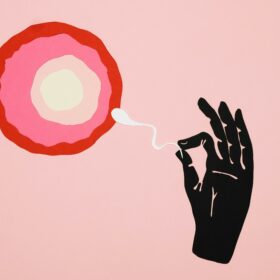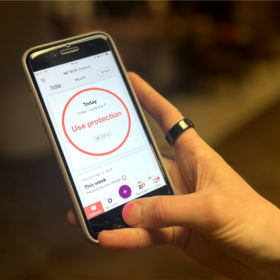
Fertility awareness methods: everything you need to know
In this article
What's the lowdown?
Natural Family Planning (NFP) or Fertility Awareness Based Methods (FABM) involves tracking fertility signs such as your menstrual cycle, cervical mucus, and basal body temperature to predict when you release an egg each month.
When you can predict which day you release an egg each month, you can avoid unprotected sex in the days around this to prevent pregnancy.
2% of couples in the UK use fertility awareness methods (1).
The methods allow you to prevent pregnancy without the use of hormones or devices.
These methods require careful monitoring and consistency. They can be effective when used correctly, but inconsistency or incorrect use can reduce their reliability, meaning you may fall pregnant.
It is a good option for those who prefer or need hormone-free contraception or want to understand their fertility better.
These methods may not be suitable for everyone, especially if an unplanned pregnancy could have serious health or emotional consequences.
What are Fertility Awareness Based Methods (FABM)?
Fertility Awareness Based Methods (FABM), also known as natural family planning, are a group of techniques used to track a woman’s fertility signs in order to prevent pregnancy2.
These methods rely on understanding and monitoring the natural rhythms of your menstrual cycle, including the timing and length of your period, ovulation, cervical mucus, and basal body temperature, without the use of hormonal medications or contraceptive devices.
The aim is to predict when an egg is released each month, and avoid sex or use condoms in the days around this to prevent a sperm meeting an egg to cause a pregnancy.
Although an egg only survives for 12 to 24 hours after it is released, sperm can survive inside the upper vagina for several days. This is why you need to avoid unprotected sex for more than one day each month to prevent pregnancy.
What are the Different Types of FABM?
There are several types of fertility awareness based methods3 which use one or a combination of “fertility indicators” to help identify the fertile window in a your menstrual cycle. These fertility indicators include:
- Fertility Awareness Rhythm Method: This method, often referred to as the calendar or rhythm method, involves tracking your cycle to predict when ovulation (release of an egg) is likely to occur. It relies on recording the length of your menstrual cycle over several months to predict your fertile period. Your ovulation day is usually between 10 to 16 days before your next period starts.
- Basal Body Temperature (BBT) Method: The basal body temperature method involves measuring your body temperature every morning before getting out of bed. It must be checked after at least 3 hours of rest or sleep before getting out of bed. A slight increase in temperature (about 0.3°C or 0.5°F) after ovulation indicates that ovulation has occurred and can help you learn which day of your cycle you usually release an egg.
- Cervical Mucus Method: Observing the changes in your cervical mucus can help identify your fertile window. Around ovulation, cervical mucus becomes clear, slippery, and stretchy, resembling raw egg whites, signaling high fertility. Monitoring the changes can help you learn which day you ovulate each cycle.
- Ovulation Kits: These kits detect a surge in luteinizing hormone (LH), which peaks 1-2 days before ovulation. This method can help pinpoint when you’re likely to ovulate and so when to avoid unprotected sex.
Other forms of fertility awareness methods include:
- The Symptothermal Method: This combines both the cervical mucus and basal body temperature methods and is more accurate at preventing pregnancy.
- Coitus Interruptus (Withdrawal Method): This method involves the man pulling out before ejaculation (before they cum). However, it is not recommended as a reliable form of contraception, as sperm can be present in pre-ejaculatory fluid (precum).
- Lactational Amenorrhoea Method (LAM): The lactational amenorrhoea method or breastfeeding amenorrhea method works for women who are exclusively breastfeeding after childbirth. The hormonal changes caused by breastfeeding prevent ovulation during the first few months postpartum.
- Digital contraceptives: Technological algorithms in apps such as Natural Cycles combine the fertility awareness rhythm method and basal body temperature method to predict your fertile window. The app advises you which days to avoid sex or use condoms and which days you are able to have sex without a condom.
How Do Fertility Awareness Methods Work?
Fertility awareness methods work by tracking and understanding the natural signs of ovulation and the fertile window in your menstrual cycle.
When you know how to predict and identify your fertile window, you then avoid sex or use a condom throughout your fertile window to stop sperm reaching an egg to form a pregnancy.
The exception to this is the lactational amenorrhoea method, which relies on the hormonal changes of breastfeeding to stop release of an egg for the first 6 months after you have had a child. To follow the lactational amenorrhoea method correctly, you need to follow strict rules for how often you are breastfeeding.
How Effective Are the Different Types of Fertility Awareness Methods?
The effectiveness of fertility awareness methods depends largely on consistency and correct use. You get out of the method what you put in. The more you practice and carefully follow the method, the less likely you are to get pregnant.
If you use only one method to track fertility, for example, just track your cycles or just check your temperature, this is only 76% effective. This means 1 in 4 couples will get pregnant each year4. Combined fertility indicators improve the effectiveness.
The symptothermal method (combination of cervical mucus and basal body temperature) has an effectiveness of up to 99%, but this might be due to the fact that couples who are using it are trained well and really committed to making it work for them, so less likely to make errors4.
Here’s how each method compares in terms of effectiveness:
- Fertility Awareness Rhythm Method: This method can work for women with regular cycles, but it’s less effective for women with irregular cycles. With perfect use, 1-9 women out of 100 may become pregnant in a year (91 to 99% effective). However, typical use may lead to 24 pregnancies per 100 women per year due to incorrect tracking or cycle variations (76% effective)4.
- Basal Body Temperature (BBT) Method: The basal body temperature method alone is 93% effective4. However it is more effective when combined with other methods, such as the cervical mucus method. Consistent daily tracking of your temperature is essential for accurate results, and you need to be aware that stress, illness or changes in your sleep can affect the readings and make it less accurate.
- Cervical Mucus Method: This method can be up to 99% effective but only when combined with other fertility signs like BBT4. Regular observation of cervical mucus changes can help identify the fertile window accurately.
- Ovulation Kits: These kits are accurate in detecting the surge in LH that occurs shortly before ovulation. However, they don’t tell you when ovulation will happen, just that it is about to occur. One study found an effectiveness rate of between 88 to 93%5.
- Lactational Amenorrhoea Method (LAM): When used correctly, LAM can be up to 98% effective during the first six months postpartum when the woman is exclusively breastfeeding. However, as breastfeeding frequency drops or if solid foods are introduced, the effectiveness of LAM decreases.
- Coitus Interruptus (Withdrawal): The withdrawal method, also known as coitus interruptus, is not a reliable form of contraception due to the possibility of sperm in precum (pre-ejaculatory fluid). It is the least effective among the fertility awareness methods with an effectiveness rate of 80% – this means that 1 in 5 couples will get pregnant each year while using this method4.
- Digital contraceptives: Natural Cycles is 98% effective if you use it perfectly and use a condom or avoid sex on red days. However it is 93% effective with typical use.6
Pros and Cons/Risks of Fertility Awareness Based Methods
Pros of fertility awareness based methods:
- Hormone-Free: these methods don’t involve any hormones or medical devices, making them a good choice for women who prefer natural contraception options or can’t use hormones.
- Increased Body Awareness: Tracking fertility signs can help women become more attuned to their bodies, which is beneficial for those trying to conceive or simply understanding their reproductive health better.
- No Side Effects: Unlike hormonal contraception methods, fertility awareness methods don’t have any side effects.
Risks or disadvantages of fertility awareness based methods
- Requires consistent tracking: To be effective, fertility awareness based methods, including the temperature method of birth control and cervical mucus monitoring, require a high level of consistency and commitment. Missing a temperature reading or not observing mucus changes can lead to inaccuracies.
- Less reliable than other methods: While effective when used correctly, fertility awareness methods may not be as reliable as other contraceptive options, particularly if cycles are irregular or if tracking is inconsistent.
- No STI Protection: Like most non-barrier contraceptives, these methods do not provide any protection against sexually transmitted infections (STIs).
If followed correctly, FABM can be effective as a method of contraception. However, in reality, there are a lot of variables which mean that this effectiveness level is quite difficult to achieve3. If used correctly and consistently, between 1 and 9 women out of a hundred women would become pregnant in one year. For women who are not consistent with the FAM, the number of women who become pregnant is more likely to be 24 per hundred women per year
Who are fertility awareness based methods suitable for?
- Women who prefer or need to use hormone-free contraception
- Women with regular cycles
- Women willing to commit to regular monitoring
- Women trying to get pregnant
Who are fertility awareness based methods not suitable for?
- Women with irregular cycles
- Women who cannot commit to regular tracking
- Women who may work shifts or change time zones regularly as this can affect the timing of ovulation each month
- Women who need highly reliable contraception
- Women who have recently stopped hormonal contraception – you should wait a minimum of 3 cycles before starting to use fertility based awareness methods and when your cycles have become regular again
Fertility awareness based methods, including the basal body temperature method, fertility awareness rhythm method, and lactational amenorrhoea method, can offer a natural and hormone-free way to manage fertility.
However, these methods require careful monitoring and a commitment to understanding your body’s rhythms.
Before deciding if natural family planning is right for you, it’s important to consider your cycle regularity, lifestyle, and willingness to track your fertility signs consistently. If you want more support in your decision, speak to one of our fantastic women’s health specialists.
Our medical review process
This article has been medically reviewed for factual and up to date information by a Lowdown doctor.





